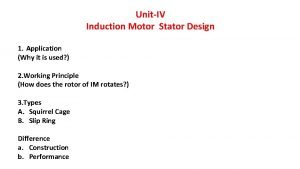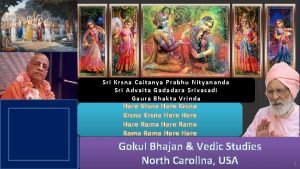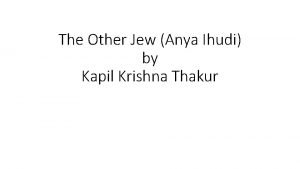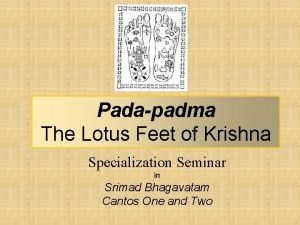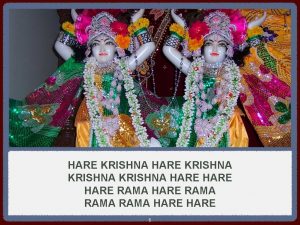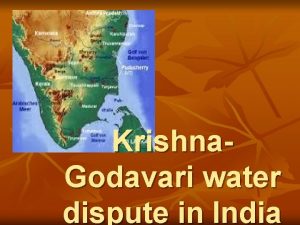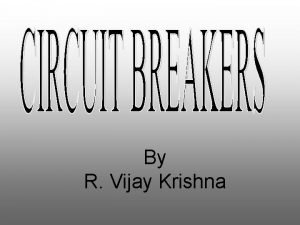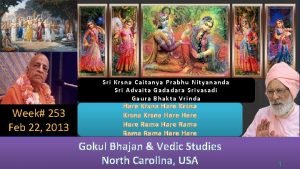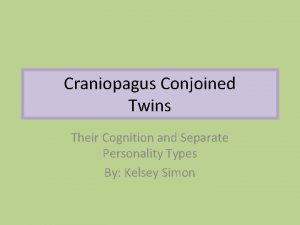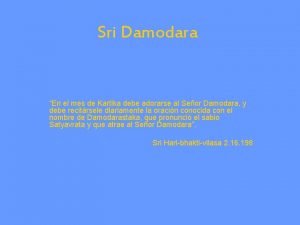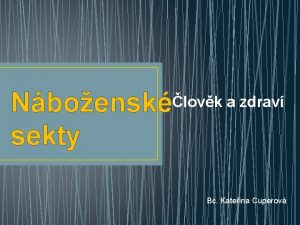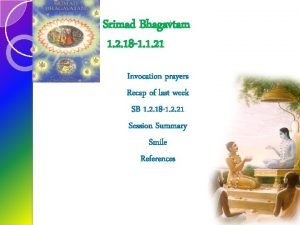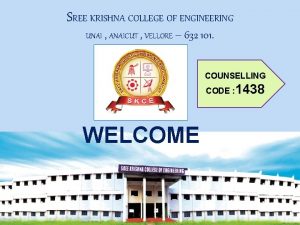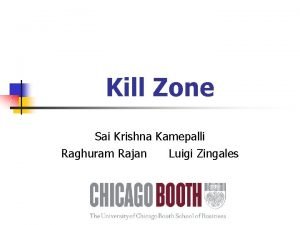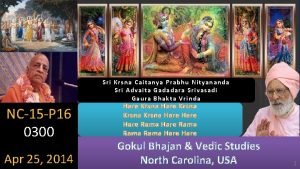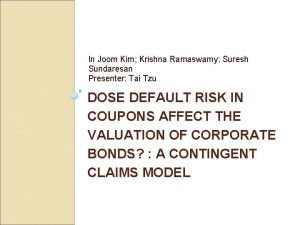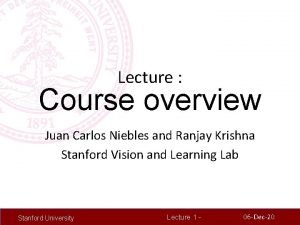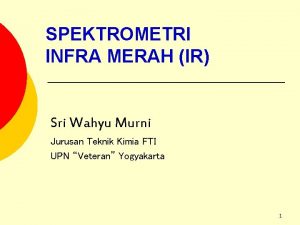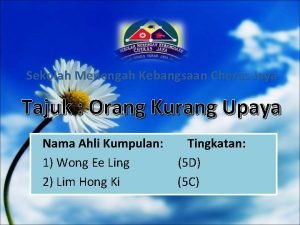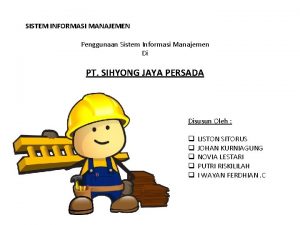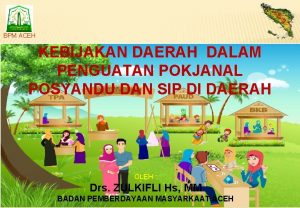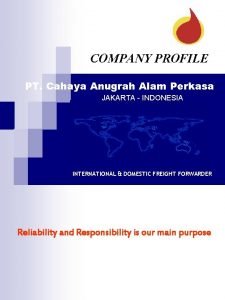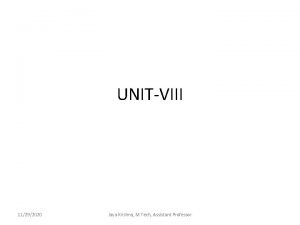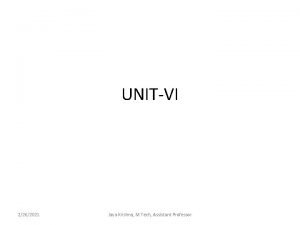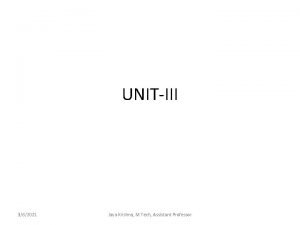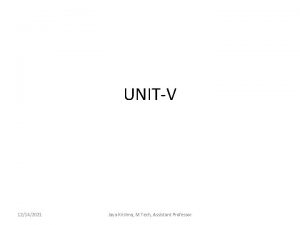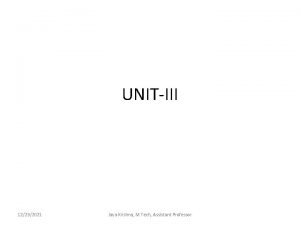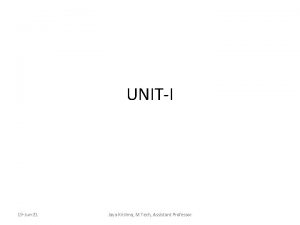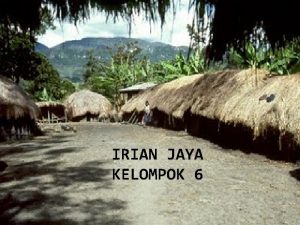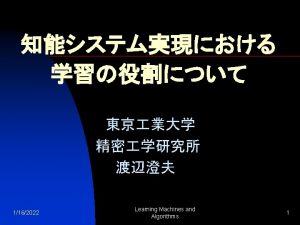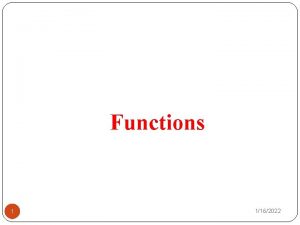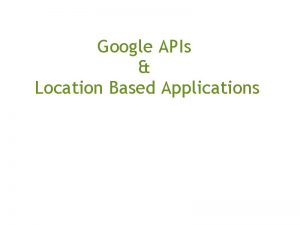UNITIV 1162022 Jaya Krishna M Tech Assistant Professor





































- Slides: 37

UNIT-IV 1/16/2022 Jaya Krishna, M. Tech, Assistant Professor

Grammar Formalism • A grammar – G = (V, Σ, P, S). Where • V finite nonempty set (variables) • Σ finite nonempty set (Terminals) • P finite set whose elements are α β (productions or production rules) – Where α and β are strings on V U Σ • S special variable (start symbol) • V Σ 1/16/2022 Jaya Krishna, M. Tech, Assistant Professor

Grammar Formalism • We observe the following regarding the production rules: – Reverse substitutions is not permitted • If S AB is a production then – Place S by AB not vice versa – No inversion operation is permitted • if S AB is a production then – Not necessary that AB S 1/16/2022 Jaya Krishna, M. Tech, Assistant Professor

Grammar Formalism • G = (V, Σ, P, S) is a grammar where – V = {<sentence>, <noun>, <verb>, <adverb>} – Σ = {Ram, Sam, ate, sang, well} – S = <sentence> • Then P consists of the following productions: – – – – 1/16/2022 <sentence> <noun> <verb> <adverb> <noun> Ram <noun> Sam <verb> ate <verb> sang <adverb> well Jaya Krishna, M. Tech, Assistant Professor

Grammar Formalism • Derivation – an ordered tree – sequence of replacements of a substring in a sentential form • Formal definition of derivation • If α β is a production in a grammar G and ϒ, δ are any two strings on V U Σ – ϒαδ directly derives ϒβδ in G 1/16/2022 Jaya Krishna, M. Tech, Assistant Professor

Grammar Formalism • For example • G = ({S}, {0, 1}, {S 0 S 1, S 01} has the productions S 0 S 1 – S in 0 S 1 00 S 11 1/16/2022 Jaya Krishna, M. Tech, Assistant Professor

Grammar Formalism • Derivation is applied – Only to left most variable at every step • Left most derivation – Only to right most variable at every step • Right most derivation 1/16/2022 Jaya Krishna, M. Tech, Assistant Professor

Chomsky Classification Chomsky language class 1/16/2022 Grammar Recognizer 3 Regular Finite Automata / Finite State Machine Push Down Automaton 2 Context free 1 Context sensitive Linear Bounded Automaton 0 Unrestricted Turing Machine Jaya Krishna, M. Tech, Assistant Professor

Chomsky Classification • Type-0 grammar – any phrase structure grammar or simply a grammar without any restrictions. – Include all formal grammars – Generate languages recognized by Turing machines 1/16/2022 Jaya Krishna, M. Tech, Assistant Professor

Chomsky Classification • Type-1 grammar – Context sensitive grammar – Productions of form • αAβ αϒβ – A is a non-terminal / variable – α, β and ϒ – strings of terminals and non terminals • α and β may be empty but ϒ must be non empty • S ε allowed – S does not appear on RHS of production Note: A language generated by the Type-1 grammar is called as Type-1 or context sensitive language. 1/16/2022 Jaya Krishna, M. Tech, Assistant Professor

Chomsky Classification • Type-2 grammar – context free grammar – only productions of the form • A ϒ • where A Є V • ϒ – string of terminals and non-terminals i. e. ϒ Є (V U Σ)*. Note: A language generated by the Type-2 grammar is called as Type-2 or context free language. 1/16/2022 Jaya Krishna, M. Tech, Assistant Professor

Chomsky Classification • Type-3 grammars – generate the regular languages – restricts its rule • single non-terminal LHS • single terminal, possibly followed or precedes, but not both RHS – Also S ε is allowed • S does not appear on RHS of any production. 1/16/2022 Jaya Krishna, M. Tech, Assistant Professor

Regular Grammar • A regular grammar – formal grammar that describes the regular language. • set of rules for rewriting the strings, along with a start symbol from which the rewriting must start • Formally – (V, Σ, P, S) 1/16/2022 Jaya Krishna, M. Tech, Assistant Professor

Regular Grammar • Two types: – Left regular – Right regular • Right regular grammar – Right linear grammar – (V, Σ, P, S) – all production rules in P are of one of the following forms: • B a • B Ac • B ε 1/16/2022 Jaya Krishna, M. Tech, Assistant Professor

Regular Grammar • Left regular grammar – left linear grammar – (V, Σ, P, S) – P is one of the following forms • A→a • A → Ba • A→ε 1/16/2022 Jaya Krishna, M. Tech, Assistant Professor

Regular Grammar • Example: – S a. S – S b. A –A ε – A c. A • S start symbol • Describes RE a*bc* 1/16/2022 Jaya Krishna, M. Tech, Assistant Professor

Regular Grammar • Example: – S Sb|a 1/16/2022 Jaya Krishna, M. Tech, Assistant Professor

EQUIVALENCE BETWEEN REGULAR LINEAR GRAMMAR AND FA • To construct regular grammar from an NFA – Assign a non-terminal symbol for each state in NFA • Ai for state i – If state i has a transition to state j on input a then • Ai a. Aj – If state i has a transition to state j on empty input then • Ai Aj – If state i is the accepting state then • Ai – If state i is the starting state then • Ai is the staring symbol 1/16/2022 Jaya Krishna, M. Tech, Assistant Professor

EQUIVALENCE BETWEEN REGULAR LINEAR GRAMMAR AND FA • CONSTRUCTION OF REGULAR GRAMMAR GENERATING T(M) FOR A GIVEN DFA M • Let M = ({q 0, … , qn}, Σ, δ, q 0, F). – W in T(M) obtained • concatenating the labels corresponding to several transitions – E. g. first from q 0 and the last terminating at some final state. 1/16/2022 Jaya Krishna, M. Tech, Assistant Professor

EQUIVALENCE BETWEEN REGULAR LINEAR GRAMMAR AND FA • Construction of grammar G – productions should correspond to transitions. – should be provision for terminating the derivation tree once a transition terminating at some final state is encountered. • Let G = ({A 0, A 1, … , An}, Σ, P, A 0) – P contains: • Ai a. Ai is included in P if δ(qi, a) = qj F • Ai a. Aj and Ai a are included in P if δ(qi, a) = qj Є F. 1/16/2022 Jaya Krishna, M. Tech, Assistant Professor

EQUIVALENCE BETWEEN REGULAR LINEAR GRAMMAR AND FA • Construct a regular grammar G generating the regular set represented by P = a*b(a + b)*. – Construct DFA as given below: 1/16/2022 Jaya Krishna, M. Tech, Assistant Professor

EQUIVALENCE BETWEEN REGULAR LINEAR GRAMMAR AND FA 1/16/2022 Jaya Krishna, M. Tech, Assistant Professor

EQUIVALENCE BETWEEN REGULAR LINEAR GRAMMAR AND FA • Let G = ( {A 0, A 1}, {a, b}, P, A 0) then – P is given by • A 0 a. A 0, • A 1 a. A 1, 1/16/2022 A 0 b. A 1, A 1 b. A 1, A 0 b A 1 a, Jaya Krishna, M. Tech, Assistant Professor A 1 b

EQUIVALENCE BETWEEN REGULAR LINEAR GRAMMAR AND FA • CONSTRUCTION OF TRANSITION SYSTEM M ACCEPTING L(G) FOR A GIVEN REGULAR GRAMMAR G • G = ({A 0, A 1, … , An}, Σ, P, A 0) – transition system M • States corresponds to variables • Initial state corresponds to A 0 • Transition in M corresponds to productions in P 1/16/2022 Jaya Krishna, M. Tech, Assistant Professor

EQUIVALENCE BETWEEN REGULAR LINEAR GRAMMAR AND FA • As Last production – Ai a • transition terminates at a new state – Unique final state • M = ({q 0, … , qn}, Σ, δ, q 0, qf) – δ defined as • Each production Ai a. Aj induces a transition from qi to qj with label a. • Each production Ak a induces a transition from qk to qf with label a. 1/16/2022 Jaya Krishna, M. Tech, Assistant Professor

EQUIVALENCE BETWEEN REGULAR LINEAR GRAMMAR AND FA • Let G = ({A 0, A 1}, {a, b}, P, A 0) – A 0 a. A 1, A 1 b. A 1, A 1 a, A 1 b. A 0 – Construct a transition system M accepting L(G) 1/16/2022 Jaya Krishna, M. Tech, Assistant Professor

EQUIVALENCE BETWEEN REGULAR LINEAR GRAMMAR AND FA • Let G = ({A 0, A 1}, {a, b}, P, A 0) – A 0 a. A 0, A 0 b. A 1, A 0 b A 1 a. A 1, A 1 b. A 1, A 1 a, A 1 b 1/16/2022 Jaya Krishna, M. Tech, Assistant Professor

CONTEXT FREE GRAMMARS • Played a central role in compiler technology since the 1960’s – they turned implementation of parsers • a formal notation for expressing recursive definitions of languages • consists of one or more variables that represent classes of strings, i. e. languages • There are rules that say how the strings in each class are constructed 1/16/2022 Jaya Krishna, M. Tech, Assistant Professor

CONTEXT FREE GRAMMAR • Formally – a 4 -tuple i. e. (V, Σ, P, S) Note: By convention, the start variable is the variable on the left hand side of the first rule. 1/16/2022 Jaya Krishna, M. Tech, Assistant Professor

CONTEXT FREE GRAMMAR E I | E E + E | E E * E | E (E) I a | I b | I Ia | I Ib | I I 0 | I I 1 • Grammar for above expressions is stated formally as – G = ({E, I}, Σ, P, E) • Σ is the set of symbols {+, *, (, ), a, b, 0, 1} • P is the set of productions shown above 1/16/2022 Jaya Krishna, M. Tech, Assistant Professor

DERIVATION TREES • The derivation in a Context Free Grammar is represented using trees. – Derivation tree / parse tree • Derivation tree for CFG G = (V, Σ, P, S) is a tree satisfying the following: – Every vertex has a label which is a variable or terminal or ε. – The root has the label S (i. e. start symbol). – The label of an internal vertex is a variable. 1/16/2022 Jaya Krishna, M. Tech, Assistant Professor

DERIVATION TREE – If the vertices n 1, n 2, . . . , nk written with labels X 1, X 2, . . . , Xk are the sons of the vertex n with label A, then A X 1 X 2. . . Xk is a production in P. – A vertex n is a leaf if its label is a Є Σ or ε. n is the only son of its father if its label is ε. • For example let G = ({S, A}, {a, b}, P, S), where P consists of S a. AS | a | SS, A Sb. A | ba. 1/16/2022 Jaya Krishna, M. Tech, Assistant Professor

DERIVATION TREE • Derivation tree is given as follows 1/16/2022 Jaya Krishna, M. Tech, Assistant Professor

DERIVATION TREE • Vertices 4 – 6 are sons of 3 written from left and S a. AS is in P. • Vertices 7 and 8 are sons of 5 written from the left, and A ba is a production in P. • Vertex 5 is an internal vertex and its label is A, which is a variable. 1/16/2022 Jaya Krishna, M. Tech, Assistant Professor

SENTENTIAL FORM • Derivations from the start symbol produce strings that have a special role – “sentential forms” • G = (V, Σ, P, S) is a CFG, – any string α in (V U Σ)* S α is. • Two types – Left sentential form left most derivation applied – Right sentential form right most derivation applied 1/16/2022 Jaya Krishna, M. Tech, Assistant Professor

LEFTMOST DERIVATION 1/16/2022 Jaya Krishna, M. Tech, Assistant Professor

RIGHTMOST DERIVATION 1/16/2022 Jaya Krishna, M. Tech, Assistant Professor
 Jaya jaya radha krishna yugala milana lyrics
Jaya jaya radha krishna yugala milana lyrics Unitiv
Unitiv Sri krsna caitanya prabhu nityananda
Sri krsna caitanya prabhu nityananda Promotion from associate professor to professor
Promotion from associate professor to professor Fok ping kwan
Fok ping kwan Low tech assistive technology definition
Low tech assistive technology definition Ihudi
Ihudi Lotus feet of krishna
Lotus feet of krishna Crishnal
Crishnal Dr murali krishna voona
Dr murali krishna voona Krishna godavari dispute
Krishna godavari dispute R. vijay krishna
R. vijay krishna Krishna education centre
Krishna education centre Pakshigan meaning
Pakshigan meaning Srnvatam sva katha krishna
Srnvatam sva katha krishna Sold goods to krishna
Sold goods to krishna Tatiana krista hogan
Tatiana krista hogan Krishna sigdel
Krishna sigdel Krishna avanti leicester
Krishna avanti leicester Krishna education centre
Krishna education centre Crishna hallada
Crishna hallada Srivasadi gaura bhakta vrinda
Srivasadi gaura bhakta vrinda Ostrihat dohola
Ostrihat dohola Krishna surya sama
Krishna surya sama Sree krishna college of engineering vellore
Sree krishna college of engineering vellore Sai krishna kamepalli
Sai krishna kamepalli Sri krishna caitanya prabhu nityananda
Sri krishna caitanya prabhu nityananda Suresh sundaresan
Suresh sundaresan Ranjay krishna
Ranjay krishna Sri wahyu c esther
Sri wahyu c esther Krishna sigdel
Krishna sigdel Krishna guadalupe
Krishna guadalupe Smk cj
Smk cj Pt sihyong jaya persada
Pt sihyong jaya persada Silsilah keturunan prabu siliwangi
Silsilah keturunan prabu siliwangi Bumd sarana jaya
Bumd sarana jaya Indonesia tanah air beta pusaka abadi nan jaya
Indonesia tanah air beta pusaka abadi nan jaya Pt anugrah alam jaya perkasa
Pt anugrah alam jaya perkasa

